

Mahogany Ship legend promised to rewrite Australian history, but is it just 19th-century fake news? Updated about 4 hours agoFri 10 Jan 2020, 10:48pm With its promises of lost treasure and the potential to rewrite Australia's history, the story of the Mahogany Ship is one of the country's most enduring and fascinating legends.
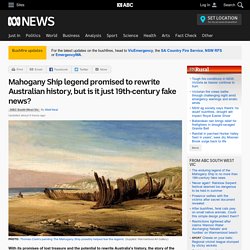
For more than 150 years, the tale of a ship that pre-dates Captain Cook supposedly buried in the sand dunes of south-west Victoria has intrigued treasure hunters and academics alike. From Spanish and Portuguese caravels to 15th-century Chinese junks, the origins of the wreck have been speculated on by historians for decades. Arctic lead deposits trace European history from the Roman Empire to modern day - Science News - ABC News. Since humans developed industry in Europe, prevailing winds have carried fine deposits of lead to the frozen Arctic, where they've been laid down like annual signatures in the permafrost.
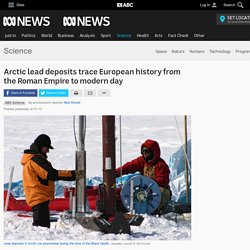
Key points: Ice core samples were taken from 13 sites in Russia and GreenlandLead increased around 250-fold after the Industrial RevolutionLead has been declining in Arctic ice cores following clean air policies introduced in the 1970s In simplest terms, the more industry in Europe, the more lead has been deposited each year in the ice. Now scientists have found frozen ice cores taken from the Arctic read like a European history book stretching back 2,200 years.
While they were expecting some correlation between lead levels and historic events, even the researchers were surprised by what they found, according to Joseph McConnell of the Desert Research Institute in Reno, Nevada. The fall of the Roman Empire and the Black Death can all be seen in Arctic lead levels. Early human fossil remains found in Philippines cave may herald new species — Homo luzonensis - Science News - ABC News. Our family tree may have grown a new branch today, with scientists announcing they have found a new species of early human in the Philippines.
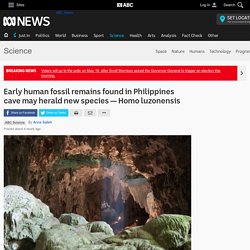
Key points Key points New species found on Luzon island in the Philippines dubbed Homo luzonensis shows a curious mix of featuresIt could be a product of the same island processes that led to evolution of the "hobbit" on the Indonesian island of FloresClaims rely on analysis of several teeth, along with hand, foot and leg bones, but not all scientists are convinced it's a new species An international team of researchers report today in the journal Nature that the discovery, dubbed Homo luzonensis, lived over 50,000 years ago on the island of Luzon. They say a handful of teeth and bones are the remains of at least three individuals — a child and two adults — of the now-extinct species. Puppets, poetry and song help Rebecca Dostal to 'own' anxiety and cope with trauma from murder, arson. Posted about 2 hours agoSat 6 Apr 2019, 11:00pm A woman who has endured trauma throughout her life says finding a voice through puppetry has finally enabled her to "own her anxiety" and reclaim her life.

Key points: A History of the World - List of Objects. Body of explorer Matthew Flinders found under London train station during HS2 dig, ending 200-year mystery. Updated 5 minutes agoThu 24 Jan 2019, 10:30pm Two hundred and sixteen years after he first circumnavigated Australia, the remains of British explorer Captain Matthew Flinders have been discovered in a burial site beneath a train station in London.
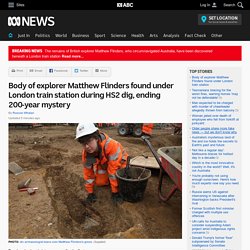
Key points: Senegal's Museum of Black Civilisations is open, asking the West to return stolen treasures. Updated about 9 hours agoWed 26 Dec 2018, 2:56pm As visitors walk through the Musée des Civilisations noires (Museum of Black Civilisations) in Senegal during its first month, global conversations around looted artefact repatriation are certain to continue.

Key points: The museum opened in early December with $48.1m of Chinese investment Its focus will be on African cultural history and the black diaspora Its curator is going to ask for the repatriation of Senegalese objects in French institutions. The Ugly History of Beautiful Things: Perfume. Katy Kelleher | Longreads | September 2018 | 15 minutes (3,859 words) If given the choice to smell like whale excrement or delicate white flowers, few people would chose the first option.

Bile, feces, vomit, and animal oils sound as though they would smell repulsive. The words conjure up scent memories of that time your dog released his anal glands on the duvet, or that summer you worked by the wharf and the August air was thick with the miasma of oily herring heads. Finding human remains could get you in trouble if you panic and do the wrong thing. Updated yesterday at 11:42pmTue 11 Sep 2018, 11:42pm.
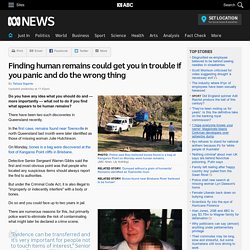
1,000 teeth and opium lamps among items found during Melbourne Metro Tunnel dig. Updated about 7 hours agoMon 27 Aug 2018, 11:53pm An unprecedented archaeological dig is underway beneath Melbourne's CBD.

In order to make way for the Metro Tunnel — a rail network that will include five new stations — a team of more than 100 archaeologists, students and staff are overseeing excavations at two locations. Here's a look at some of the 500,000 artefacts they've found in the digs so far: Piles of teeth washed down the sink Yes. Map of Indigenous massacres grows to include more sites of violence across Australia. Updated 12 minutes agoFri 27 Jul 2018, 3:12am For hundreds of years, Aboriginal and Torres Strait Islander people have spoken about the murders of Indigenous tribes that occurred across the nation during frontier times.
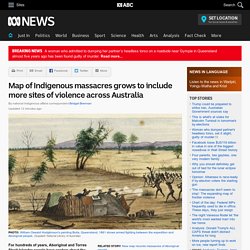
Key points: Landmark project mapping Indigenous massacres from 1788-1930 now includes 250 sites across AustraliaExtensive new research details killings in Queensland, South Australia and the NTResearch team contacted by hundreds of Australians offering insights about where Indigenous groups were killed Now a landmark project mapping those massacres has hit a sobering point — 250 sites have been documented across almost every state and territory.
Coin found off Arnhem Land coast could be among Australia's oldest foreign artefacts. Updated about 3 hours agoMon 9 Jul 2018, 11:01pm An uninhabited island off the coast of Arnhem Land may seem worlds apart from medieval Africa, but believe it or not, they're more connected than you'd think. In 1944, a RAAF serviceman found several coins on a deserted beach on one of the Wessel Islands, off the Northern Territory coast, but the exact location of the discovery remained a mystery.
Now, almost eight decades later, researchers believe they've found another coin — this time on Elcho Island, which is also in the Wessel Island group. The 1944 coins were linked to the east African city of Kilwa, off modern-day Tanzania. Ravenswood mine: Stories of bodies unearthed in unmarked cemetery come to life after 150 years. Posted A sailor who took his own life, a mother who died in childbirth, and a solicitor struck by lightning are among 16 people who were buried in an unmarked cemetery in the historic goldmining town of Ravenswood, however nearly 150 years after their deaths, their stories have come alive.
The bodies were discovered in September last year when mining company Carpentaria Gold started preparations for expansion of their Ravenswood mine 130 kilometres south-west of Townsville. "There were maps and a few newspaper articles from the 1870s but [the original cemetery] had never been gazetted so it had never been acknowledged as such," said Carpentaria Gold's Rebecca McLellan. The mining company engaged historians Margaret Cook, Narelle Hancock and Ray Holyoak to determine the location and size of the lost cemetery using maps, newspaper articles, and an old artwork from the era.
The Black Death. AC History Units. Level: Year 8 Topic: Angkor Australian Curriculum: History reference – Depth Study 2 The Asia Pacific World, Angkor/Khmer Empire (c. 802- c. 1431) The Year 8 program: the Asia-Pacific world – Angkor (PDF, 105 KB) outlines a series of 21 lessons. The learning sequence in this unit selects lessons 8-12 from this program and suggests how they might be approached. A rich collection of source material is provided, as well as instructions for teachers seeking guidance in working with historical sources. While the learning sequence deals with lessons 8-12, the following resources have been provided to support activities suggested in other lessons in the program: History Sites And Resources For Students In Year 8 Stage 4.
Fuedal Japan. 30+ Ways to Teach History Without a Textbook. History is my biggest passion; I love history! I am a firm believer teaching history should never be boring. And yet, I really don’t like textbooks. More often than not, they’re boring, and they make it hard to retain information in the long run. (Thus, you’re not really learning.) As an alternative, here are 30+ ways to teach history without a textbook, from books to cooking, and more! Explore Resources. Pages Showing 1–10 of 1153 results Grade Level: High School (9-12), College and Beyond. DocsTeach. Humanities and Social Sciences. Britannica School. Indigenous influence on AFL creation confirmed by historical transcripts, historian says. Updated In a week when AFL vilification again raised its ugly head in the media, further evidence has emerged about the game's Indigenous origins, with a historian citing transcripts she says proves a key Aboriginal influence. Key points: Transcripts prove Indigenous game Marngrook was played where AFL inventor Tom Wills grew upMarngrook and Australian Rules Football are strikingly similarAFL sticking to official history denying Marngrook influence Monash University historian Professor Jenny Hocking found transcripts placing Indigenous football, commonly known today as Marngrook, firmly in the Western district of Victoria where Australian rules founder Tom Wills grew up.
Aheadofhistory: Quick guide to historical significance. Why Study History? Yr 7 bias. New Page 2. Home - History Skills Online. HSI: Historical Scene Investigation. March on Frankfort, “Who goes down in history?” Becoming a Detective.
Archaeology. Medieval History. Ancient History. PreHistory.